Issue #251: Redistricting Wars Part 3: Democrats vow to fight back with their own maps
A look at the Democratic answers to Trump's gerrymandering
Over the last couple weeks, I have written two extensive deep dives into the nationwide redistricting fight going on in America. Dubbed the “Redistricting Wars” - this drive to redraw Congressional districts was kickstarted by President Trump pushing for Texas to reconfigure its lines to increase Republican seats in Congress. Such a process of redrawing lines with a specific outcome in mind, in this case for partisan advantage, is known as gerrymandering.
The issue of gerrymandering is known to some degree by many Americans, but it is hardly a universally known or understood practice. As a result, I first wrote an article that look into the history of redistricting and gerrymandering in America. That article, seen below, looks not only at the fact that gerrymandering is as old as the country itself, but also looks at where the current Congressional map is gerrymandered.
In that first article, I looked at Republican and Democratic gerrymanders in differing states. While both parties are guilty of the issue, the current Congressional map has more Republican gerrymanders than Democratic; allowing the map to have a GOP bias. The imbalance due to a combination of Republicans controlling more states and several Democratic-controlled states having independent redistricting commissions. As I also delved into in that article, Democrats in recent years were the ones to push state level and nationwide independent redistricting efforts; moves opposed by Republicans almost across the board.
My second issue looks at the current Republican push to redraw lines in several states. Trump started with pressuring Texas Republicans to carve out FIVE more Republican-leaning seats. In addition, the Trump White House is pushing Republicans in states like Missouri and Indiana to also redraw their lines and crack up Democratic-held seats.
In that article, I got into the specifics of the Texas redraw and what new lines in Missouri or Indiana may look like. The Texas redraw, which I go into more coverage in the above article, is drawn to eliminate FIVE districts held by Democrats and convert them into double-digit Trump seats. The new map is seen below.
I also diligently point out how this is being drive by the Trump team aiming to hold on to the House next year. As Democrats open up a lead in the generic ballot for next year’s midterms, the Republicans redrawing districts are openly admitting their reasoning is partisan. Trump directly stated that the Texas map was designed to give them “five more seats.”
This article will now look at what Democrats are doing in response to the Republican remaps. As many readers already know, California is putting a new Congressional map up for voter approval this November. This map aims to draw out several Republicans; a counter to the Texas map. In addition, states like Maryland, Illinois, and New York are looking at remaps as well.
Lets dive in.
How to Respond to the GOP Maps?
The push by Republicans to gerrymander districts heading into the 2026 midterms had led to a broad debate within many circles about how to respond. Democrats have spent over a decade pushing for nationwide redistricting reform, while “Good Government” groups have taken gerrymanders of both parties to task.
However, in the wake of the White House directing changes to election maps, many longtime reformers have been forced to re-evaluate their tactics, at least in the short term.
Where can Democrats Fight Back?
One big issue for Democrats is that they cannot hope to redistrict in as many states as Republicans can. This is due to the combination of who controls which state and that several blue states have independent commissions.
The map below shows which states could redistrict and which party has control. All states in grey are either “maxed out” in how far their maps can go, are in divided government, or have commissions that cannot be overruled by 2026. (On this note, I will be getting into New York later on).
Democrats have limited areas they can remap compared to the GOP. Granted right now Republicans are focused on Texas, Missouri, and Indiana. A remap will also take place in Ohio and maybe Florida, which I will discuss more in later articles. Republicans are already pretty maxed out with the deep south.
Regardless of the exact final breakdown of which states remap, the point is, Democrats are at a disadvantage. However, Democrats have clearly resolved to fight as much as they can.
Democrats Resolve to Fight Back
When the Texas remap news first hit, now several weeks ago, Democrats were initially divided on how to respond to the move. The key issue was simple, should Democrats respond by re-drawing maps in the states they control, trying to offset the gains Republicans are making with their gerrymandering.
A huge part of the problem: The party has split into two factions.
One is ready to ditch the long-running practice of nonpartisan redistricting wherever possible, recognizing that the new Texas map would put the recapture of the House all but out of reach.
The other group of Democrats is dreading a map-making arms race that the party would be waging on uneven turf, all while exposing its members to charges of hypocrisy after their years-long push for fair congressional districts.
There was a serious sentiment form several Democrats that an arms race with Republicans was not a good idea. After all, more states are in Republican hands, giving them more areas to change maps.
The debate within the party waged. For example, Colorado Senator John Hickenlooper, also a former Governor, was against passing gerrymanders in response to the Republican efforts.
“What they’re doing is wrong,” Sen. John Hickenlooper, D-Colo., told Semafor when asked about Texas Republicans. “It’s this win-at-any-cost devolution of our political system. But I don’t think the response is to undo the good work that’s been done.”
However, this sentiment quickly lost out to the side of the party that is resolved to fight back with map changes of their own. Former Texas Congressman Beto O'Rourke laid out the key argument for why the unseemly practice of gerrymandering in response is the only real option.
“I buy the argument that we don’t like Republicans doing it, [so] we certainly shouldn’t do it as well,” he said. “But this is for the very future and fate of the Republic. We lose it, you will never, ever get it back.”
Democratic politicians have pointed out that while gerrymandering is a long-used practice in the country - the fact that we see the President of the United States pushing for remaps directly is a dangerous new development. In an interview, Democratic Governor JB Pritzker highlights specifically that Trump has said the Texas remap is because his party “deserves to have five more seats.”
“What’s even rarer is to do it at the behest of the president of the United States, who’s clearly attempting to and says that he deserves to have five more seats.”
In the same article, former Obama Attorney General Eric Holder makes this historic point very clear. Trump is the first President to get involved in redistricting like this. Neither Obama or Biden, both who were Presidents in the 2011/2012 and 2021/2022 remap seasons, push states to adopt specific maps.
“When Barack Obama was president, when Joe Biden was president, did either of those presidents call a governor of a state or a state legislature and tell them to gerrymander to find five seats for them? No,”
Democratic Governors have quickly moved to embrace remaps to counter the GOP effort. This swing in favor of “screw them, we will gerrymander back” no doubt was aided by it being clear Republicans would not stop at Texas. Regardless of what Democrats did, remaps in places like Missouri and Indiana were likely, so there is no reason to disarm.
“It’s incumbent upon Democrat governors, if they have the opportunity, to respond in kind, I’m not a big believer in unilateral disarmament.” (Kansas Gov Laura Kelly)
It is an unsettling dynamic to be put in, where if you long believed in independent redistricting, you might now be forced to engage in tit-for-tat partisan remapping. It is not good for voters or for good governance. However, to stop the creation of a congressional map that becomes rigged to benefit the party in power, you have little other choice.
There is much more to be said for the debate about gerrymandering in response, but before I further delve into that debate, let us take a look at what Democratic-leaning states are responding with their own maps.
California’s Remap Plan
Among all states in Democratic control, the biggie is California. No other state has the possibility to squeeze out enough Republicans to balance what has been done in Texas.
California’s Independent Commission
Like several democratic-run states, California draws its lines via an independent redistricting commission. This came thanks to a 2010 ballot measure pushed by good government groups. When independent redistricting passed in 2010, it left politicians out of the map-making process.
Before the commission came into being , California has a long history of gerrymandering. The 2002 Congressional plan was not a partisan gerrymander, but instead an “incumbent gerrymander,” Such a plan is exactly what it sounds like, a plan agreed to by both parties to protect their incumbents. That plan served two interests
It preserved current Republican seats in a state only getting more Democratic
It ensured the white democratic incumbents would be kept safe from primary challenges as their districts grew increasingly racially diverse
When the independent commission passed in 2010, it set up a 2011 remap process that hurt several incumbents of both parties. The new map was actually much better for Democrats as a whole, with the 2012 elections seeing them gaining several seats. Meanwhile, several democratic incumbents either did not run for re-election or LOST to other Democratic candidates. The incumbent gerrymander of 2002 had been bad for the national Democratic Party. Republicans subsequently realized that a more balanced map was actually worse for them; as they’d been propped up by the 2002 map.
The independent commission remained and redrew lines after the 2020 census. Democrats were not able to gerrymander the 2022 lines, which saw Democrats lose two seats in that year’s midterms. In 2024 Democrats made a batch of gains, holding all the seats Harris won: a delegation of 43 to 9.
Republicans will claim that California’s current map is a gerrymander. However, the struggle of Republicans to get into the 15 to 20 seat range has been their struggles to win non-white voters at high enough margins. Gains with Hispanics in recent years have not been enough to break through on many seats. Losing California by 20% in 2024 was actually a pretty high water mark, as Republicans have often lost it by around 30 points. The current map aims to unite and give power to California’s many racial and language minority communities. As long as Republicans struggle with these voters, they will struggle in California.
If Republicans really think the current map is a gerrymander, they would be shocked what Governor Newsom rolled out.
Newsom Responds to Texas
As the push for Texas to redraw its lines gained steam in July, California began looking at ways to respond to maintain the balance in the House map. The moves by Texas and Trump put longtime backers of independent redistricting in line with Democrats who felt that responding with their own map was a must.
Professor Sara Sadhwani, one of the members of the 2021 independent redistricting commission, laid things out plainly.
“I stand by the work of the commission of course. We drew fair and competitive maps that fully abided by federal laws around the Voting Rights Act to ensure communities of color have an equal opportunity at the ballot box, That being said, especially when it comes to Congress, most certainly California playing fair puts Democrats at a disadvantage nationally.”
Sadhwani put things even more succinctly
“I think it’s patriotic to fight against what appears to be our democracy falling into what appears to be authoritarian rule,”
As Texas underwent its remap process, California Governor Gavin Newsom quickly made it clear that his state would respond. Newsom made it plain, if Texas did not stand down, California would respond with its own remap.
In his letter to the President, Newsom laid it out how destabilizing Trump’s redistricting move was.
You are playing with fire, risking the destabilization of out democracy, while knowing that California can neutralize any gains you hope to make. This attempt to the rig the congressional maps to hold onto power before a dingle vote is cast in the 2026 election is an affront to American Democracy.
As the Texas debate went on, Newsom and legislative lawmakers meet to iron out a plan. Due to the independent commission in California’s constitution, a new congressional plan could not just be drafted. Lawmakers and the Governor eventually came to an agreement on how to move forward. A map that would be approved by the voters in November of 2025.
The New Map Proposal
On August 18th, California released its proposed Congressional map, set to be used for the 2026, 2028, and 2030 elections. The map aimed to shrink Republicans into just five seats.
More details can be found in the above link. A full breakdown of the partisan makeup of the map can be seen below. Under the proposal, Trump won just 5 of the 52 districts in 2024. Republicans are packed as much as they can be.
As mentioned before, there are 9 Republican Congresspeople in California right now. All sit in Trump districts. The changes to their seats can be seen below. Three of the nine are instantly in Harris +10 seats. Two others are in marginal districts, one that narrowly went for Harris and one narrowly for Trump.
Seats the like 22nd, which were once very Democrats but have swung to the right, could see a swing-back to the left in a blue midterm. In all, this map aims to give Democrats the possibility at flipping 3 to 5 seats; a balance to the Texas proposal. Donald Trump has expressed his fury about the proposal, sating that he intends for the DOJ to sue in federal court over the plan. There is little reason to think that will succeed.
Trump tried to intimidate Newsom to back down before the vote happened in the legislature. At a rally the Governor held in Los Angeles, ICE and Border Patrol agents showed up outside the event.
The Governor’s twitter had some fun mocking this, but I would stress it is only more proof that Trump is trying replicate the authoritarian and strongman mantra. Sending your federal goons to an opposition rally is really autocrat 101. It only furthers the argument for fighting back.
Proposition 50
On August 21s, both chambers of the California legislature passed the map as part of a constitutional amendment. On November 4th, voters will be asked to approve the new map as a work-around to the independent redistricting commission. This measure, Proposition 50, will specifically NOT repeal independent redistricting in California but merely replaces the congressional map for the rest o this census. The ballot summary reads as follows..
In response to Texas' mid-decade partisan congressional redistricting, this measure temporarily requires new congressional district maps, as passed by the Legislature in August 2025, to be used in California's congressional elections through 2030.
Retains California's independent Citizens Redistricting Commission and directs the Commission to resume enacting congressional district maps in 2031 after the 2030 census and every ten years thereafter.
Establishes state policy supporting use of fair, independent, and nonpartisan redistricting commissions nationwide.
You can read more on the measure here. The amendment will see likely tens of millions spent. Polling right now has the YES side in a comfortable lead, but money will be spent on all sides to influence voters. I plan to discuss the campaign more in a future article.
Additional Democratic States
While California has dominated coverage of Democratic remaps, there are a few additional blue states that could act. However, no other state can have the impact the new California map will have if it passes.
New York
The second biggest Democratic-run state than can alter its map is New York. However, their process to drafting new lines is more complicated than California, and any remap will not affect 2026. The state uses an independent commission, similar to California.
In 2022, Democrats tried to force through an extreme gerrymander (map here) - but it was rejected by the courts and a temporary map was put in place for the election. Democrats were able to pass a finalized map in 2024. That map did increase the Democratic margin of a few seats, and is considered a modest gerrymandering - not going nearly as far as many Democrats wanted. I went over this in more detail in my Issue 249.
For New York Democrats to pass a new map, one that would likely make the 11th and 1st, as well as maybe one additional district, Democratic, they would need to override the constitution with a new ballot measure, similar to California.
Governor Kathy Hochul has been supportive of a remap effort, laying out her position pretty straight forward in the wake of the Texas remap - “This is war!”
Hochul and Democratic lawmakers have met to discuss the path forward on redistricting. A key hiccup is that any ballot measure must be approved by the legislature twice. A measure must be approved by this current legislature, and then by a legislature elected in 2026’s midterms.
Only with those two passages can a ballot measure be put forward - so we are taking November of 2027. That could yield a new map for the 2028 elections, but not before. If you want a sense of what kind of map could be passed for 2028, see the original gerrymander plan that the courts stopped Democrats from implementing back in 2022.
We will need to see how New York moves forward.
Maryland
Maryland is likely one of the easier states to make changes to its Congressional map. The state currently has a 7-1 map, with a Republican-aligned district based in the more conservative eastern end of the state.
In 2021, Democrats passed a Congressional plan that would have been potentially 8-0, with the eastern district taking in Democratic heavy areas across the water. However, this plan was subject to the veto of the then-Governor Larry Hogan, a Republican, and a state court strike down.
However, with Democrats in full control of the state, there is rumbling of a possible remap. Governor Wes Moore, a Democrat elected in 2022, has left the door open to redistrict the state.
Other Possible States
There are rumblings across several other states for possible remaps, but most of these would be delayed or minimal.
Illinois is considering a remap, which would likely only net 1 additional seat, as the state is already heavily gerrymandered.
Oregon could try to eliminate its last Republican-aligned seat, similar to Maryland.
Virginia and Colorado both use commissions and any map changes would likely not come till 2028, a similar dynamic to New York.
All in all, especially for 2026, California is the Democrats best hope to offset Texas’s map. As for other Republican remaps in Indiana or Missouri, Democrats have to look to places like Maryland or Illinois to balance the scales more.
One More Article to Go
With the last three articles, I hope I have laid out clearly and succinctly what the status of gerrymandering is in America and the politics behind the current “war” going on. I will also be adding in articles on remaps for Florida and Ohio; likely later this months.
Before then, I do have one final article to go on this “redistricting wars” series. That article will lay out clearly why advocates for independent redistricting, and I am one of those advocates, are right to push the “fine you gerrymander, we gerrymander back” sentiment. This ties in heavily with what I argued at the end of Issue 150; that Donald Trump’s anti-democracy sentiment makes these latest GOP gerrymandering efforts even more dangerous than normal.
That article will look at the debate within good government circles, as some have resigned themselves to the need for California and others to change their maps, while others rigidly stick to “no gerrymandering ever.” I am firmly on the side of those who have resigned themselves to the “its not pretty but we have no other choice” camp.
That article will be out in a couple days.






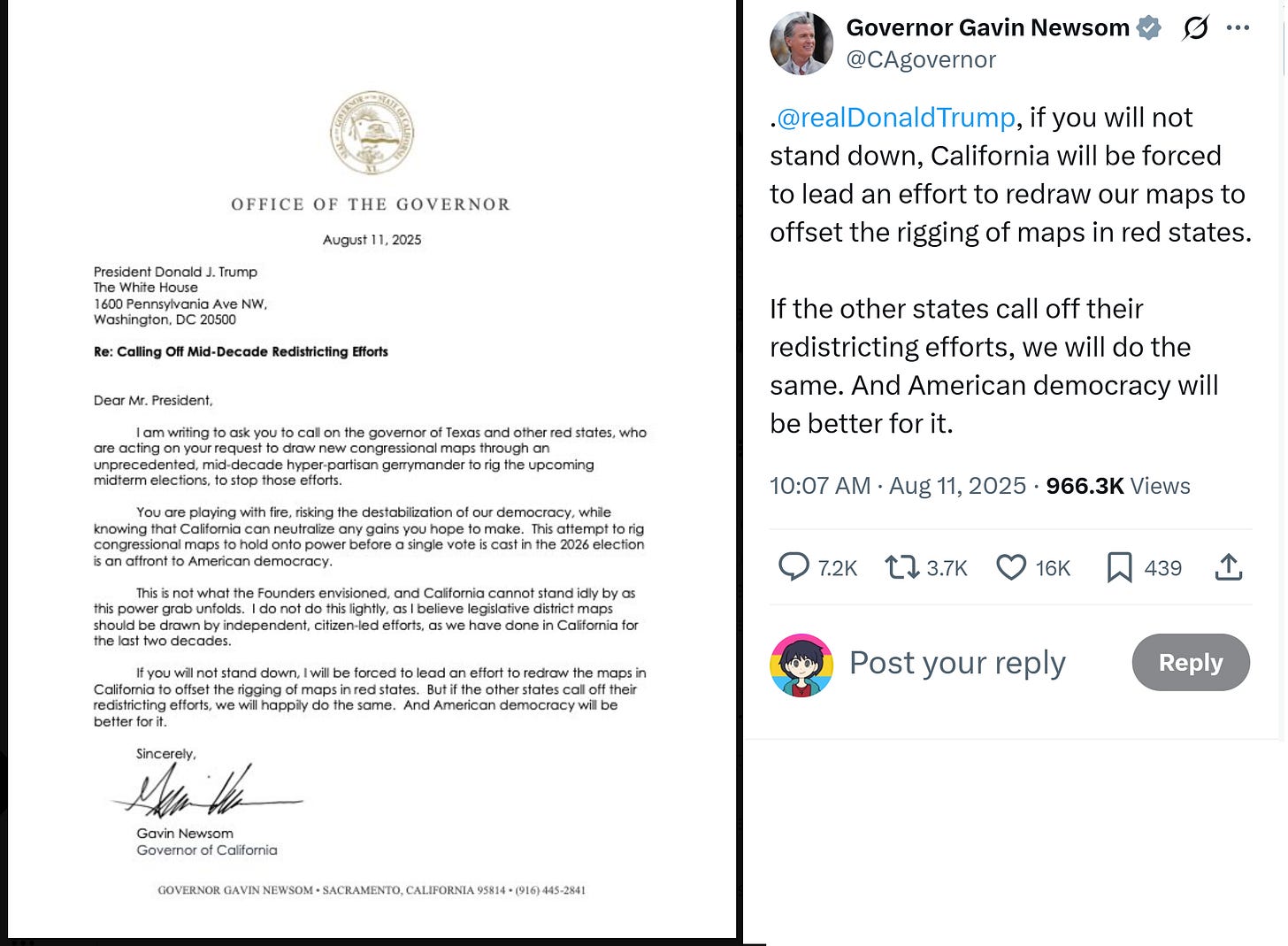
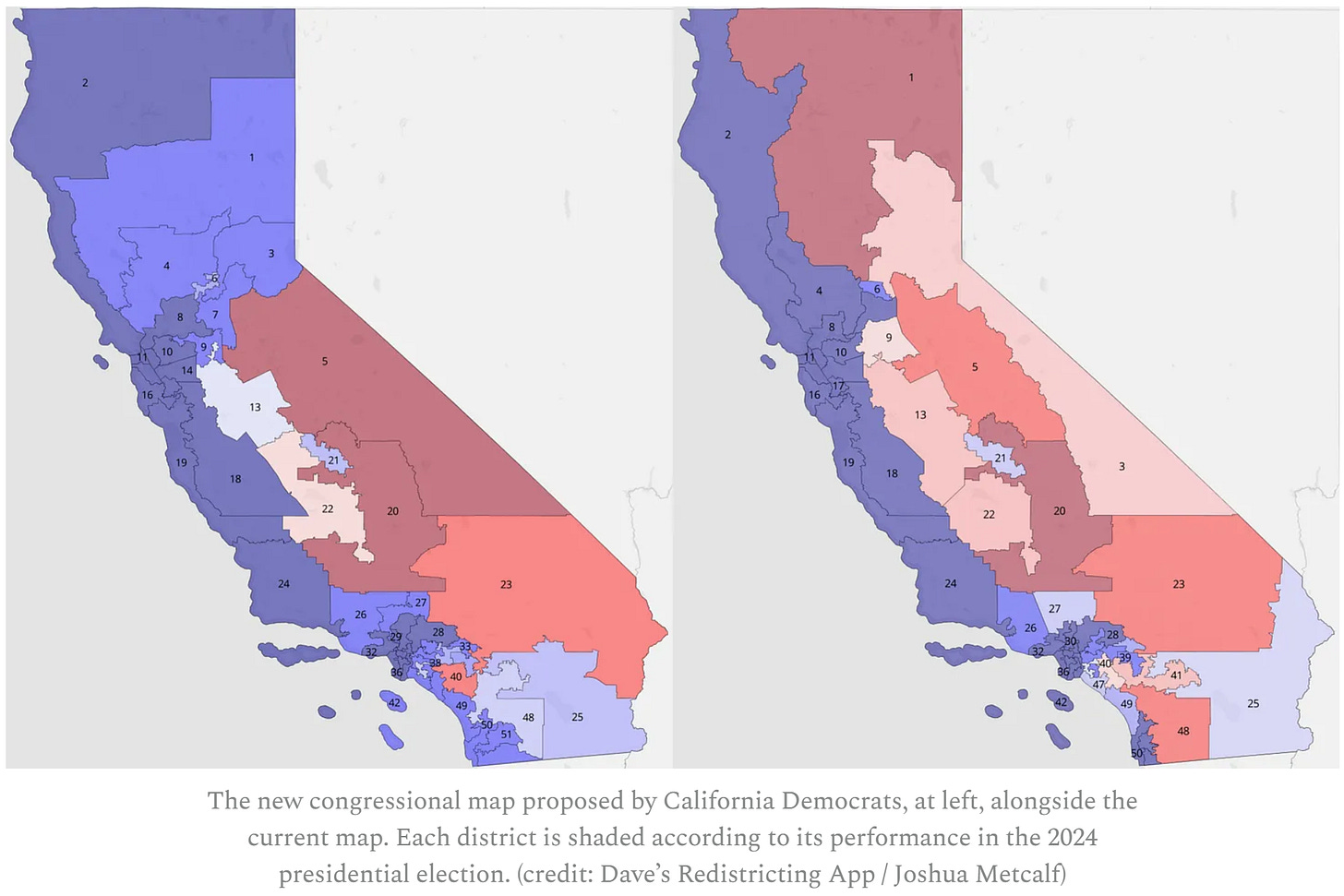

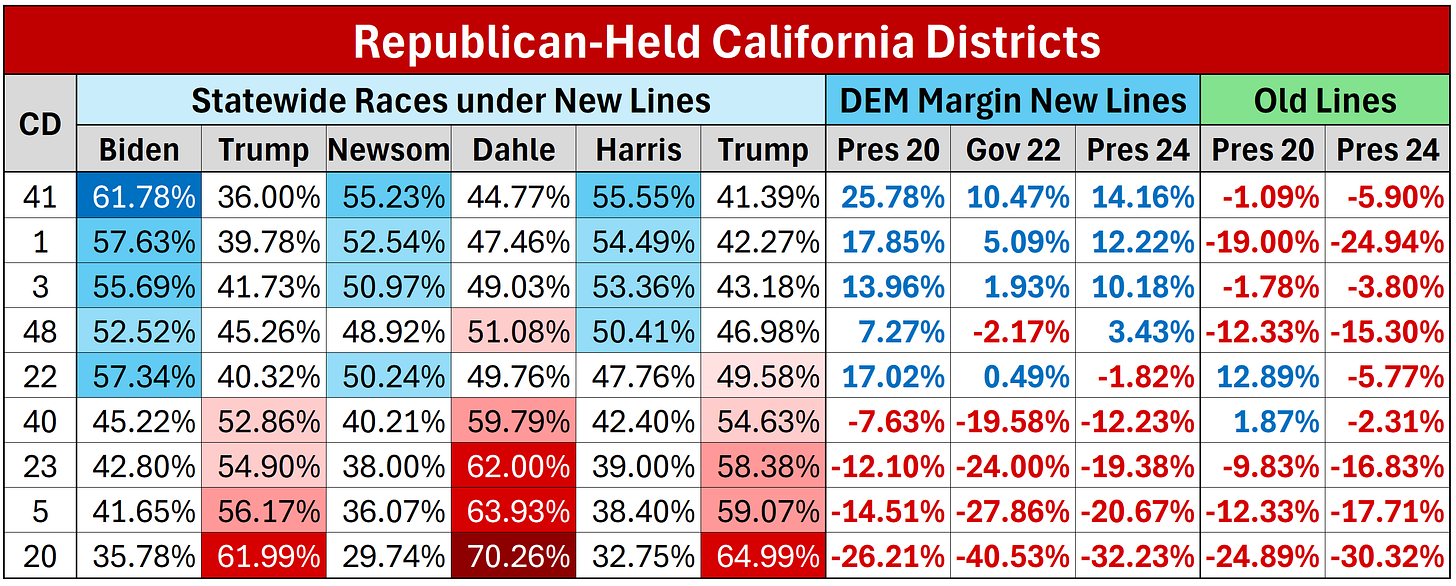

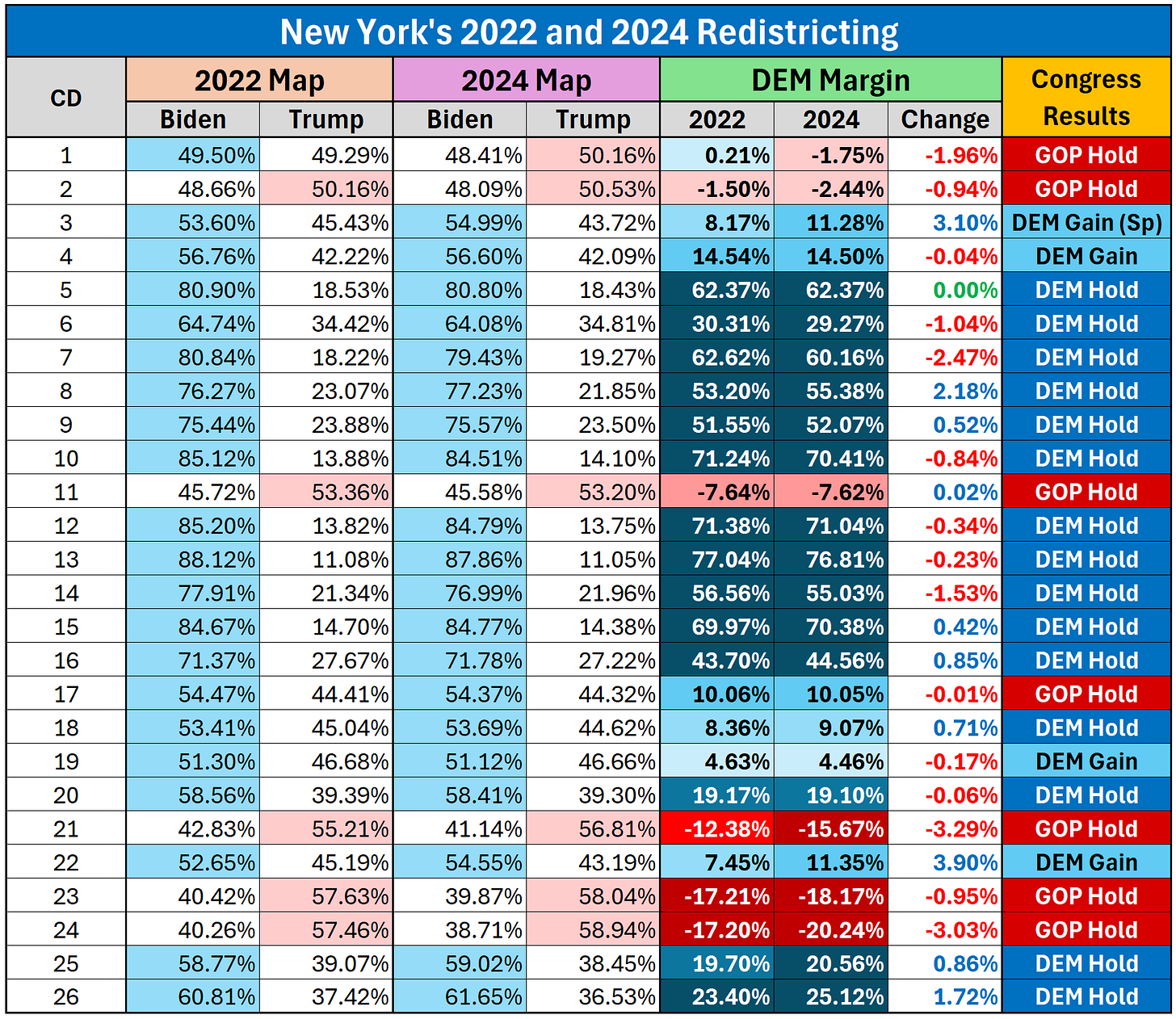
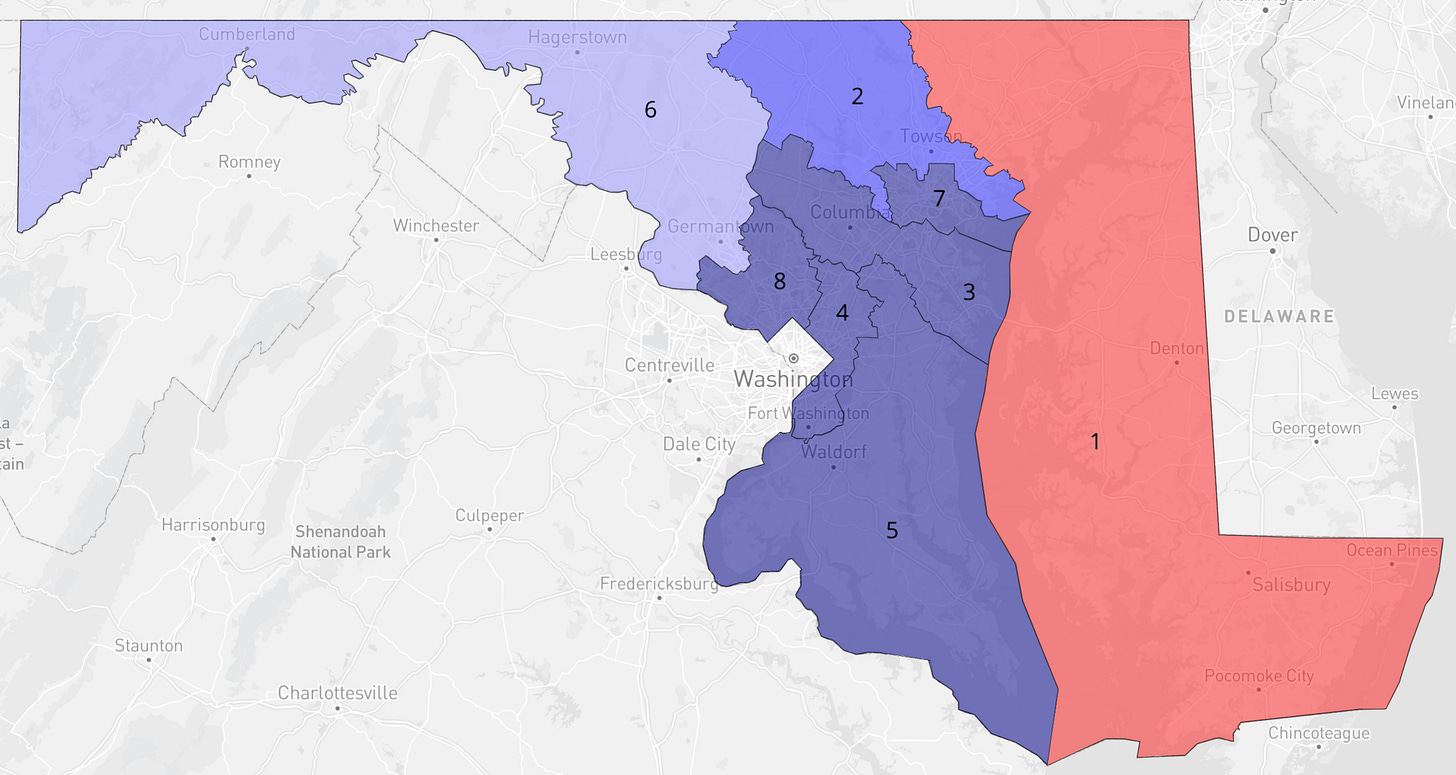
I am enjoying your coverage on the gerrymander wars. One question, now that a Utah state court has ordered a redraw of the state’s congressional map, will you be examining it in your last article?